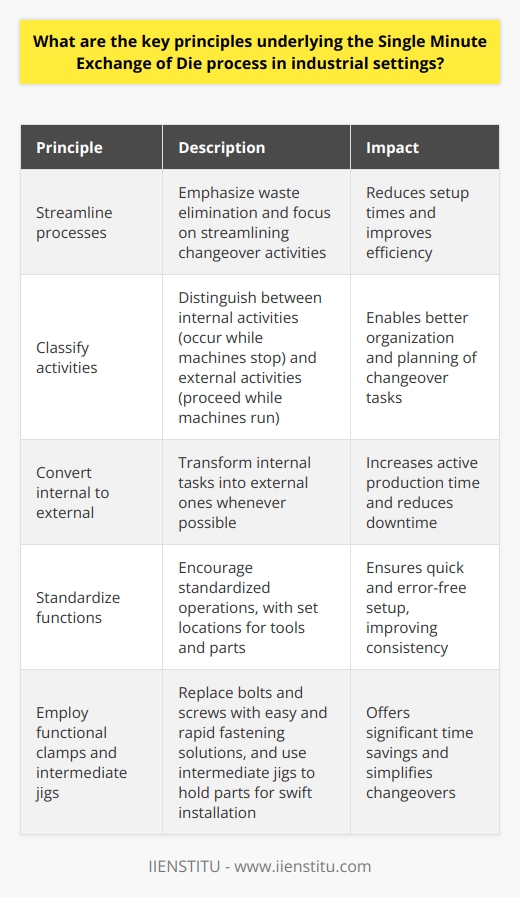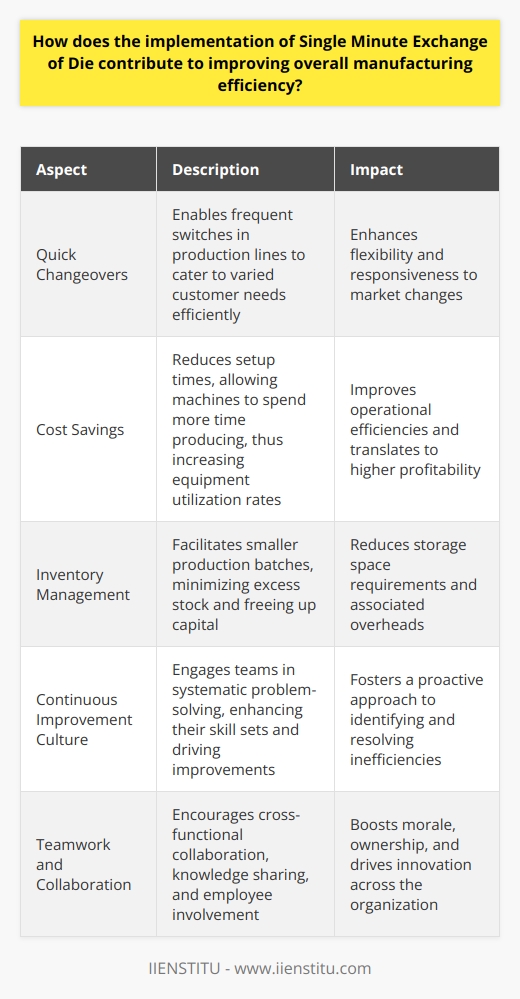
In a world where industries constantly strive for efficiency and swift transitions in their operational processes, the concept of Single Minute Exchange of Die, or SMED, emerges as a pivotal methodology. This system, originally developed to reduce the time taken for equipment setup, has transcended to become a foundational principle in manufacturing and production environments. SMED is not merely a technique but a strategic approach that synergizes with principles of lean manufacturing to produce a significant reduction in changeover times.
This blog aims to dissect and understand the intricacies of SMED, exploring its history, implementation, benefits, and challenges, as well as reviewing real-world applications that showcase its transformative impact on the industry. Readers will gain comprehensive insights into why SMED remains an indispensable tool for companies aiming to thrive in the competitive manufacturing sector.
History of Single Minute Exchange of Die
Origins and development of SMED: The roots of SMED stem from post-World War II Japan, where industries were pressured to maximize output with limited resources. The challenge was to minimize machine setup times that could take several hours, sometimes an entire shift. The concept of SMED was fertilized in this soil of necessity, progressively transforming what was then a burdensome task into a streamlined operation. It condensed the changeover time from hours to minutes—hence the term 'single minute.'
Pioneer experts and their contributions: Shigeo Shingo, a Japanese industrial engineer, was pivotal in developing and formalizing the SMED methodology. During the 1950s and 1960s, Shingo collaborated with Toyota and other manufacturers to break down changeover tasks into distinct elements, categorizing them into those that could be done while the machine was running (external) and those that could only be performed when the machine was stopped (internal). His relentless pursuit of efficiency through meticulous analysis and creative solutions is a testament to expert-level problem solving, which is at the core of SMED.
Evolution and current status of SMED: From its inception to the current industrial landscape, SMED has evolved from an innovative idea to a standard practice within lean manufacturing sectors around the globe. Today, it is part of comprehensive problem solving training courses and is prominently featured in multiple online certificate course offerings. Its principles have been refined, adapted, and implemented across a variety of complex production settings, cementing its status as an enduring and adaptive aspect of industrial efficiency practices.
Understanding Single Minute Exchange of Die
Explaining the SMED concept: At its core, SMED is a systematic approach that reduces the time a machine is non-productive due to setup or changeover processes. These are the minutes (or, optimistically, the single minute) that the 'exchange of die' occurs—not in the literal change of a die or mold in every instance, but in the metaphorical sense of transitioning a production apparatus from one task to another.
The significance of the term "single minute" in SMED: The phrase "single minute" does not restrict the changeover process to a span of 60 seconds but rather emphasizes the goal of reducing changeover times to under 10 minutes. This target represents a radical improvement from the lengthy changeovers that were common before SMED. By focusing on this ambitious threshold, the philosophy challenges organizations to rethink and re-engineer their setup activities.
The role of 'Die' in SMED: In the realm of SMED, 'Die' stands symbolically for any set up or tooling requirement necessary for a specific production batch. The essence lies in optimizing the procedure of changing this 'setup' rapidly and efficiently. Although originally pertinent to the die-casting and stamping processes, the term 'Die' within SMED has expanded to imply the adaptable methodology applicable in multiple setup scenarios.
Basic principles of SMED: Understanding the foundational principles of SMED is crucial for implementing the strategy effectively. It begins with separating the setup into internal and external processes, identifying areas of waste or inefficiency, and standardizing best practices. Each step of the setup is scrutinized and re-imagined, utilizing techniques such as preparatory procedures, functional clamps, and fine-tuning adjustments to effectuate rapid changeovers.
Key elements of SMED implementation
Stages of SMED process: Implementation of SMED is typically broken down into stages: initial stages involve observing current procedures to identify inefficiencies; intermediate stages focus on separating and converting internal setups to external ones; while advanced stages strive for continuous improvement, aiming to refine the process until the 'single minute' goal is achieved or is as close to that target as realistically possible.
Internal and external setup: In the context of SMED, internal setup refers to actions that cannot take place unless the machine operation has ceased, and external setups are those that can be conducted while the machine is still running. One of the first steps of a successful SMED process is shifting as many activities as feasible from internal to external setup, thus reducing machine downtime.
Examples of converting internal setup to external setup: A compelling example of this conversion would be the pre-heating of dies or molds so they are ready for immediate use, thereby bypassing the time formerly wasted waiting for components to reach operating temperature during the machine's downtime. Another would involve the prep of materials and tools in advance, ensuring a seamless transition.
Streamlining the SMED process: Streamlining evolves through innovations like quick-release mechanisms and locators to decrease the time needed to affix or remove components from machinery. Adopting a meticulous and disciplined approach to storing and handling tools and parts also contributes significantly to the elimination of non-value-adding time during changeovers.
Benefits and challenges of using SMED
Productivity improvements through SMED: Productivity leaps are some of the most obvious benefits of employing SMED. By cutting down on setup time, machines spend more time in actual production, leading to a greater output and more efficient use of resources. This improvement translates into a competitive advantage through faster production times and increased flexibility to meet customer demands.
Reducing waste and increasing efficiency with SMED: SMED is intertwined with principles of lean manufacturing. It focuses on the elimination of waste—specifically, the waste of time. By streamlining changeovers, companies can reduce inventory levels because of the ability to switch production lines rapidly, thus responding quickly to market changes and reducing the overhead costs associated with holding large amounts of stock.
Potential challenges in SMED implementation: However, SMED is not without its challenges. These can range from resistance to change within an organization, difficulties in training personnel, to the physical limitations of existing machinery. Moreover, conceptual challenges such as misunderstanding the difference between value-added and non-value-added steps can hinder the process.
How to overcome these challenges: To address these challenges, a robust approach could include comprehensive problem solving training courses to ensure workforce alignment with SMED principles. Additionally, regular audits and reviews of procedures, and fostering a culture of continuous improvement can act as counterweights to implementation obstacles. Gradual and consistent enhancements typically yield better results than attempting to enforce large-scale changes abruptly.
Case studies of successful SMED implementations
Reviewing various industries where SMED principles have been successfully deployed
Case studies across diverse industries such as automotive, food and beverage, and electronics manufacturing have illustrated the universal applicability and success of SMED. These examples highlight the transformative nature of the methodology when applied diligently and tailored to the specific context of an operation.
Lessons from successful SMED implementation
Key lessons from such success stories often underline the importance of leadership commitment, detailed planning, employee involvement, and the creative use of technology. Through examination of these cases, it becomes evident that while tools and techniques are integral, the ultimate driving force behind successful SMED implementation is the human element.
The impact of SMED on manufacturing processes
The impact of SMED on manufacturing processes is profound. It not only accelerates throughput but also enhances the ability to deliver quality products within shorter timeframes. By incorporating SMED into their operational DNA, companies can gain the agility needed to adapt in a market where speed and flexibility are increasingly critical determinants of success.
Conclusions and future outlook for SMED
Recapitulation of key points
As we conclude, we revisit the essential aspects of SMED: the methodical reduction of changeover times to improve operational efficiency, the evolution from Japanese manufacturing environments to global application, and the strategies required for its successful deployment. Each of these facets plays a vital role in the efficacy of SMED.
The role of SMED in shaping future manufacturing practices
As manufacturing practices evolve, the principles of SMED continue to hold significance in striving for leaner and more responsive production cycles. In an era obsessed with optimization, the SMED methodology remains highly relevant and continues to be a cornerstone in operational excellence initiatives.
How SMED can adapt to the digital era
In the digital era, SMED stands poised to integrate further with advanced technologies such as predictive analytics, IoT (Internet of Things), and AI (Artificial Intelligence). Such technologies can foreseeably enhance the SMED framework, ushering in a new era of digital-guided efficiency where real-time data and machine learning contribute to the continual refinement of setup times.
The development and insights into SMED stem from a myriad of academic publications, case studies, and historical accounts that chronicle the journey from its inception to modern-day practices. Industrial engineering texts, lean manufacturing guides, and journals in production optimization are indispensable resources that substantiate the lessons and principles discussed in this exposition.
Frequently Asked Questions
What are the key principles underlying the Single Minute Exchange of Die process in industrial settings?
Fundamentals of Single Minute Exchange of Die (SMED)
Understanding SMED
Single Minute Exchange of Die (SMED) improves manufacturing efficiencies. It is a systematic approach. SMED drastically reduces equipment setup times. This method enables quick changeovers. It greatly supports lean manufacturing.
Principles of SMED
Streamline processes. The SMED framework emphasizes waste elimination. Focus is on streamlining changeover activities.
Classify activities. SMED requires a clear distinction. Activities are either internal or external. Internal activities occur while machines stop. External activities proceed while machines run.
Convert internal to external. SMED strategies aim to transform internal tasks. These become external whenever possible. This switch improves active production time.
Standardize functions. SMED encourages standardized operations. Tools and parts have set locations. Standardization ensures quick and error-free setup.
Use functional clamps. It advocates for easy and rapid fastening. Functional clamps replace bolts and screws. This change offers significant time savings.
Employ intermediate jigs. Intermediate jigs hold parts for swift installation. They are pivotal in simplifying changeovers.
Adopt parallel operations. Workers conduct activities simultaneously. This approach shortens overall setup time.
Fine-tune procedures. Constant refinement of changeover steps is crucial. SMED promotes ongoing optimization.
Train for flexibility. Workforce cross-training equips teams with diverse skills. Flexibility boosts efficiency during changeovers.
Impacts and Strategies
Benefits of Applying SMED
Applying SMED principles elevates productivity. It contributes to less downtime. Firms experience increased operational flexibility. They can respond quickly to customer demand.
Strategies for Effective Implementation
Develop a changeover team. A dedicated team fosters successful implementation. They can analyze and refine processes.
Record current methods. Video footage captures existing procedures. Analysis identifies wasteful steps.
Prioritize easy wins. Initially focus on changes yielding immediate results. Momentum builds and supports further changes.
Educate the workforce. Comprehensive training underpins the SMED philosophy. A well-informed team executes changes more effectively.
Monitor progress. Regular assessments ensure that improvements continue. Feedback loops enhance setup procedures.
In conclusion, adopting the SMED method transforms manufacturing operations. It cuts waste. It amplifies flexibility. It uplifts competitiveness in a dynamic industrial landscape.

How does the implementation of Single Minute Exchange of Die contribute to improving overall manufacturing efficiency?
The Essence of SMED
Single Minute Exchange of Die (SMED) holds critical importance in manufacturing. It represents a methodology for reducing equipment setup times. This efficiency improvement process has a direct bearing on decreasing production lot sizes. Furthermore, it enables a quicker response to customer demands.
Unveiling SMED's Key Advantages
Quick changeovers remain at SMED's core. These enable frequent switches in production lines. As a result, companies can cater to varied customer needs more efficiently. Flexibility emerges as a prime benefit, allowing manufactures to swiftly adapt to market changes.
Manufacturers realize significant cost savings with SMED. By slashing setup times, machines spend more time producing. Hence, equipment utilization rates rise. Higher utilization directly translates to enhanced operational efficiencies.
Inventory management also sees improvements. Lower setup times facilitate smaller production batches. This shift minimizes excess stock and frees up capital. It diminishes storage space too, reducing overheads for the company.
Moreover, SMED fosters a culture of continuous improvement. Teams engage in systematic problem-solving, enhancing their skill sets. They identify inefficiencies and implement solutions swiftly.
A Closer Look at the Process
Standardized procedures form SMED's backbone. Each step in setup processes gets thorough documentation. Teams can then analyze these steps for time-saving opportunities.
The method segregates setup actions into two categories:
- Internal activities (performed when equipment is stopped)
- External activities (executed while machinery is running)
SMED's goal involves converting internal activities into external ones. Doing so allows operations to continue while preparations for the next process occur.
Achieving Excellence through Teamwork
Successful SMED implementation requires teamwork. Cross-functional teams collaborate, sharing knowledge across departments. Ideas flow freely in this environment, propelling improvements.
Employees receive training in the SMED framework. They gain the skills necessary to drive down changeover times actively. Their involvement increases morale and fosters a sense of ownership over their work.
The Cumulative Impact
SMED has a profound, compound effect on operations. Each incremental improvement builds upon the last. Companies cultivate an ability to shift gears quickly and seamlessly. Responsiveness to market conditions becomes a competitive edge.
In summarizing, SMED serves as a pivotal tool in manufacturing. It enhances flexibility, cuts costs, and improves efficiency. This methodology also underpins lean manufacturing principles. In turn, it propels companies towards operational excellence.

What are the challenges faced during the application of the Single Minute Exchange of Die system and what strategies are recommended for overcoming these challenges?
Challenges in Implementing SMED
Implementing the Single Minute Exchange of Die (SMED) system poses several challenges. Often, these revolve around resistance to change, setup complexity, and operational disruptions. Here, we dissect these challenges and offer strategic solutions.
Resistance to Change
Many facilities encounter resistance to changing established procedures. Employees may fear new methods. They may lack understanding or confidence. Anxiety about possible failure deters initiative.
Strategies:
- Engage and Educate: Openly discuss SMED's benefits. Provide comprehensive training.
- Involve Employees: Include team members in planning. Solicit their feedback.
- Celebrate Successes: Highlight early wins. Recognize individual contributions.
Complexity of Setup Procedures
Complex setups present significant SMED challenges. Such intricacy demands meticulous analysis. It often requires substantial time investments.
Strategies:
- Simplify Processes: Break down complex setups. Search for simplification opportunities.
- Standardize Components: Use uniform parts where possible. Reduce variability.
- Document Clearly: Create easy-to-follow setup guides. Implement visual aids.
Operational Disruptions
Switching to SMED can disrupt ongoing operations. Teams might experience downtime during the transition. Productivity could temporarily decline.
Strategies:
- Plan Meticulously: Schedule changes during off-peak hours. Minimize impact.
- Communicate Vigorously: Keep all stakeholders informed about the transition.
- Phase Implementation: Introduce SMED gradually. Avoid radical overhauls.
Lack of Continuous Improvement
After initial success, momentum can wane. Continuous improvement is vital. Without it, process gains may revert.
Strategies:
- Track Performance: Monitor setup times. Aim for consistent reductions.
- Foster a Kaizen Culture: Promote ongoing, incremental improvements.
- Review Regularly: Hold frequent evaluations. Adjust as necessary.
Equipment and Tooling Constraints
Old or inflexible equipment hinders rapid changeovers. Specialized tooling can complicate setups.
Strategies:
- Invest in Upgrades: Where feasible, modernize machinery.
- Create Dedicated Tool Sets: Assemble tools specific to each setup.
- Design for Quick Changeovers: Consider retrofitting machines for easier switching.
Conclusion
While the SMED system improves efficiency, it brings challenges. Resistance, complexity, disruptions, stagnation, and equipment issues test resolve. However, the outlined strategies can help organizations overcome these hurdles. Critical to success are employee buy-in, process simplification, careful planning, continuous improvement, and appropriate investments in equipment. With these approaches, companies can reap the full benefits of SMED.


